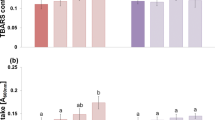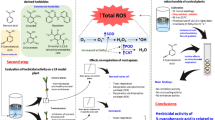Abstract
The apical 2 cm of seedling roots of oilseed rape (Brassica napus L., cv. ‘Primor’) produced more ethylene than adjacent, older tissue. Treatment with ⩽ 5 × 10−3 mol m−3 3,5-diiodo4-hydroxybenzoic acid (DIHB), a presumed inhibitor of ethylene action, failed to stimulate root extension. Larger concentrations were inhibitory. Ethylene, applied as ethephon decreased root extension but DIHB (5 × 10−3 mol m−3) partially overcame this effect. Oxygen concentrations below that present in air also inhibited root extension but this was not ameliorated by DIHB.
Roots of barley seedlings (Hordeum vulgare L., cv. ‘Midas’) evolved ethylene more slowly than roots of oilseed rape. DIHB (10−3−10−2 mol m−3) stimulated root extension in the absence of ethephon. Ethephon alone retarded root extension but DIHB partially overcame this inhibition. Small concentrations of oxygen also inhibited root extension but DIHB failed to ameliorate the effect even though the slow growth of oxygen-deficient roots (3–5% oxygen) was associated with abnormally fast rates of endogenous ethylene production.
Extension growth in different oxygen concentrations was more closely associated with rates of oxygen consumption than with the amount of ethylene produced. Thus respiration rather than ethylene appeared to limit root extension under oxygen deficiency. This may explain why DIHB was unable to offset this form of environmental stress.
Similar content being viewed by others
References
Alejar AA (1979) Alleviation of some physiological effects of salinity on barley with 3,5-diiodo-4-hydroxybenzoic acid. Philipp J Sci 107:13–22
Bertani A and Brambilla I (1982) Effect of decreasing oxygen concentration on wheat roots: Growth and induction of anaerobic metabolism. Z Pflanzenphysiol 108:283–288
Bradford KJ and Dilley DR (1978) Effects of root anaerobiosis on ethylene production, epinasty and growth of tomato plants. Plant Physiol 61:506–509
Bradford KJ and Yang SF (1980) Xylem transport of 1-aminocyclopropane-1-carboxylic acid, an ethylene precursor, in waterlogged tomato plants. Plant Physiol 65:322–326
Drew MC, Jackson MB and Giffard S (1979) Ethylene-promoted adventitious rooting and development of cortical air spaces (aerenchyma) in roots may be adaptive responses to flooding in Zea mays L. Planta 147:83–88
Hiatt AJ and Lowe RH (1967) Loss of organic acids, amino acids, K, and Cl from barley roots treated anaerobically and with metabolic inhibitors. Plant Physiol 42:1731–1736
Imaseki H, Watanabe A and Odawara S (1977) Role of oxygen in auxin-induced ethylene production. Plant and Cell Physiol 18:577–586
Jackson MB (1982) Ethylene as a growth promoting hormone under flooded conditions. In: Wareing PF, ed. Plant Growth Substances 1982, pp 291–301. London: Academic Press
Jackson MB and Campbell DJ (1975) Movement of ethylene from roots to shoots, a factor in the responses of tomato plants to waterlogged soil conditions. New Phytol 74:397–406
Jackson MB and Campbell DJ (1976) Waterlogging and petiole epinasty in tomato: The role of ethylene and low oxygen. New Phytol 76:21–29
Jackson MB and Goss MJ (1978) Can stress experienced by root systems be alleviated by exogenous growth regulators? In: Opportunities for Chemical Plant Growth Regulation, Monograph 21, pp 95–103. Croydon: British Crop Protection Council/British Plant Growth Regulator Group
Kays SJ, Nicklow CW and Simons DH (1974) Ethylene in relation to the response of roots to physical impedance. Plant Soil 40:565–571
Konings H and Jackson MB (1979) A relationship between rates of ethylene production by roots and the promoting or inhibiting effects of exogenous ethylene and water on root elongation. Z Pflanzenphysiol 92:385–397
Larqué-Saavedra A, Wilkins H and Wain RL (1975) Promotion of cress root elongation in white light by 3,5-diiodo-4-hydroxybenzoic acid. Planta 126:269–272
Raskin I, Kende H (1984) Regulation of growth in rice seedlings. J Plant Growth Regulation 2: 193–203
Robert ML, Taylor HF and Wain RL (1975) Ethylene production by cress roots and excised cress root segments and its inhibition by 3,5-diiodo-4-hydroxybenzoic acid. Planta 126:273–284
Robert ML, Taylor HF and Wain RL (1976) The effect of certain phenolic acids on growth and ethylene production of cress seedling roots. Planta 132:95–96
Saini GR (1979) Root elongation and plant growth in a basal till compact soil treated with 3,5-diiodo-4-hydroxybenzoic acid and gibberellic acid. Agron J 71:1067–1070
Smith AM and ap Rees T (1979) Effects of anaerobiosis on carbohydrate oxidation by roots of Pisum sativum. Phytochem 18:1453–1458
Smith KA and Robertson PD (1971) Effect of ethylene on root extension of cereals. Nature 234:148–149
Thomas, TH ed (1982) Plant Growth Regulator Potential and Practice, p 200. Wellesbourne: British Plant Growth Regulator Group. Croydon: British Crop Protection Council
Trought MC, Drew MC (1980) The development of waterlogging damage in young wheat plants in anaerobic solution cultures. J Exp Bot 31:1573–1585
Wain RL, Taylor HF, Intarakosit P and Shannon TGD (1968) Halogen derivatives of 4-hydroxybenzoic acid as root growth stimulants and the importance of light in this response. Nature 217:870–871
Wilkins H, Alejar AA and Wilkins SM (1978) Some effects of halogenated hydrobenzoic acids on seedling growth. In: Opportunities for Chemical Plant Growth Regulation, Monograph 21, pp 83–94. Croydon: British Crop Protection Council/British Plant Growth Regulator Group
Wilkins H, Larqué-Saavedra A and Wain RL (1974) Control of Zea root elongation by light and the action of 3,5-diiodo-4-hydroxybenzoic acid. Nature 248:449–450
Wilkins SM, Wilkins H and Wain RL (1976) Chemical treatment of soil alleviates effects of soil compaction on pea seedling growth. Nature 259:392–394
Wilkins H, Wilkins SM and Wain RL (1977) Studies on plant growth-regulating substances XLVIII. The effects of 3,5-diiodo-4-hydroxybenzoic acid on seedling growth in compact and loose soils. Ann Appl Biol 87:415–422
Author information
Authors and Affiliations
Rights and permissions
About this article
Cite this article
Jackson, M.B., Dobson, C.M., Herman, B. et al. Modification of 3,5-diiodo-4-hydroxybenzoic acid (DIHB) activity and stimulation of ethylene production by small concentrations of oxygen in the root environment. Plant Growth Regul 2, 251–262 (1984). https://doi.org/10.1007/BF00124773
Issue Date:
DOI: https://doi.org/10.1007/BF00124773




